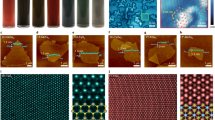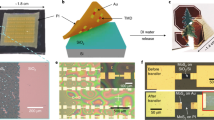Abstract
In the pursuit of ultrasmall electronic components1,2,3,4,5, monolayer electronic devices have recently been fabricated using transition-metal dichalcogenides6,7,8. Monolayers of these materials are semiconducting, but nanowires with stoichiometry MX (M = Mo or W, X = S or Se) have been predicted to be metallic9,10. Such nanowires have been chemically synthesized11,12,13. However, the controlled connection of individual nanowires to monolayers, an important step in creating a two-dimensional integrated circuit, has so far remained elusive. In this work, by steering a focused electron beam, we directly fabricate MX nanowires that are less than a nanometre in width and Y junctions that connect designated points within a transition-metal dichalcogenide monolayer. In situ electrical measurements demonstrate that these nanowires are metallic, so they may serve as interconnects in future flexible nanocircuits fabricated entirely from the same monolayer. Sequential atom-resolved Z-contrast images reveal that the nanowires rotate and flex continuously under momentum transfer from the electron beam, while maintaining their structural integrity. They therefore exhibit self-adaptive connections to the monolayer from which they are sculpted. We find that the nanowires remain conductive while undergoing severe mechanical deformations, thus showing promise for mechanically robust flexible electronics. Density functional theory calculations further confirm the metallicity of the nanowires and account for their beam-induced mechanical behaviour. These results show that direct patterning of one-dimensional conducting nanowires in two-dimensional semiconducting materials with nanometre precision is possible using electron-beam-based techniques.
This is a preview of subscription content, access via your institution
Access options
Subscribe to this journal
Receive 12 print issues and online access
$259.00 per year
only $21.58 per issue
Buy this article
- Purchase on Springer Link
- Instant access to full article PDF
Prices may be subject to local taxes which are calculated during checkout




Similar content being viewed by others
References
Kondo, Y. & Takayanagi, K. Synthesis and characterization of helical multi-shell gold nanowires. Science 289, 606–608 (2000).
Qin, L. C. et al. Materials science—the smallest carbon nanotube. Nature 408, 50 (2000).
Xiang, J. et al. Ge/Si nanowire heterostructures as high-performance field-effect transistors. Nature 441, 489–493 (2006).
Yanson, A. I., Bollinger, G. R., van den Brom, H. E., Agrait, N. & van Ruitenbeek, J. M. Formation and manipulation of a metallic wire of single gold atoms. Nature 395, 783–785 (1998).
Ohnishi, H., Kondo, Y. & Takayanagi, K. Quantized conductance through individual rows of suspended gold atoms. Nature 395, 780–783 (1998).
Radisavljevic, B., Radenovic, A., Brivio, J., Giacometti, V. & Kis, A. Single-layer MoS2 transistors. Nature Nanotech. 6, 147–150 (2011).
Wang, Q. H., Kalantar-Zadeh, K., Kis, A., Coleman, J. N. & Strano, M. S. Electronics and optoelectronics of two-dimensional transition metal dichalcogenides. Nature Nanotech. 7, 699–712 (2012).
Yin, Z. et al. Single-layer MoS2 phototransistors. ACS Nano 6, 74–80 (2012).
Cakir, D., Durgun, E., Gulseren, O. & Ciraci, S. First principles study of electronic and mechanical properties of molybdenum selenide type nanowires. Phys. Rev. B 74, 235433 (2006).
Murugan, P., Kumar, V., Kawazoe, Y. & Ota, N. Assembling nanowires from Mo–S clusters and effects of iodine doping on electronic structure. Nano Lett. 7, 2214–2219 (2007).
Kibsgaard, J. et al. Atomic-scale structure of Mo6S6 nanowires. Nano Lett. 8, 3928–3931 (2008).
Venkataraman, L., Hong, Y. S. & Kim, P. Electron transport in a multichannel one-dimensional conductor: molybdenum selenide nanowires. Phys. Rev. Lett. 96, 076601 (2006).
Venkataraman, L. & Lieber, C. M. Molybdenum selenide molecular wires as one-dimensional conductors. Phys. Rev. Lett. 83, 5334–5337 (1999).
Liu, X. et al. Top down fabrication of sub-nanometre semiconducting nanoribbons derived from molybdenum disulfide sheets. Nature Commun. 4, 1776 (2013).
Egerton, R. F., Li, P. & Malac, M. Radiation damage in the TEM and SEM. Micron 35, 399–409 (2004).
Zhou, W. et al. Intrinsic structural defects in monolayer molybdenum disulfide. Nano Lett. 13, 2615–2522 (2013).
Zan, R. et al. Control of radiation damage in MoS2 by graphene encapsulation. ACS Nano 7, 10167–10174 (2013).
Komsa, H-P. et al. Two-dimensional transition metal dichalcogenides under electron irradiation: defect production and doping. Phys. Rev. Lett. 109, 035503 (2012).
Popov, I., Gemming, S., Okano, S., Ranjan, N. & Seifert, G. Electromechanical switch based on Mo6S6 nanowires. Nano Lett. 8, 4093–4097 (2008).
Lee, J., Zhou, W., Pennycook, S. J., Idrobo, J-C. & Pantelides, S. T. Direct visualization of reversible dynamics in a Si6 cluster embedded in a graphene pore. Nature Commun. 4, 1650 (2013).
Radisavljevic, B., Whitwick, M. B. & Kis, A. Integrated circuits and logic operations based on single-layer MoS2 . ACS Nano 5, 9934–9938 (2011).
Wang, H. et al. Integrated circuits based on bilayer MoS2 transistors. Nano Lett. 12, 4674–4680 (2012).
Chau, R., Doyle, B., Datta, S., Kavalieros, J. & Zhang, K. Integrated nanoelectronics for the future. Nature Mater. 6, 810–812 (2007).
Novoselov, K. S. et al. Electric field effect in atomically thin carbon films. Science 306, 666–669 (2004).
Regan, W. et al. A direct transfer of layer-area graphene. Appl. Phys. Lett. 96, 113102 (2010).
Krivanek, O. L. et al. An electron microscope for the aberration-corrected era. Ultramicroscopy 108, 179–195 (2008).
Svensson, K., Jompol, Y., Olin, H. & Olsson, E. Compact design of a transmission electron microscope-scanning tunneling microscope holder with three-dimensional coarse motion. Rev. Sci. Instrum. 74, 4945–4947 (2003).
Ren, B., Picardi, G. & Pettinger, B. Preparation of gold tips suitable for tip-enhanced Raman spectroscopy and light emission by electrochemical etching. Rev. Sci. Instrum. 75, 837–841 (2004).
Acknowledgements
The authors thank H. Conley for helping with the transfer of the samples, E. Rowe, E. Tupitsyn and P. Bhattacharya for early technical assistance on the samples, and R. Ishikawa, R. Mishra, B. Wang and J. Lou for discussions. This research was supported in part by the US Department of Energy (DOE; grant DE-FG02-09ER46554 to J.L. and S.T.P.), a Wigner Fellowship through the Laboratory Directed Research and Development Program of Oak Ridge National Laboratory (ORNL), managed by UT-Battelle, LLC, for the US DOE (W.Z.), the Office of Basic Energy Sciences, Materials Sciences and Engineering Division, US DOE (A.R.L., N.J.G., J.Q.Y., D.G.M., S.J.P. and S.T.P.) and through a user project supported by ORNL's Center for Nanophase Materials Sciences (CNMS), which is sponsored by the Scientific User Facilities Division, Office of Basic Energy Sciences, US DOE (J.C.I.). K.I.B. and D.P. were supported by ONR N000141310299. This research used resources of the National Energy Research Scientific Computing Center, which is supported by the Office of Science of the US DOE (contract no. DE-AC02-05CH11231). O.C. and K.S. acknowledge the Japan Science and Technology Agency (JST) research acceleration programme for financial support. N.T.C., M.O. and S.O. acknowledge support from the JST-CREST programme.
Author information
Authors and Affiliations
Contributions
J.L. and O.C. designed and carried out the experiments and analysed the data. J.L. performed the STEM experiments and first-principles calculations. O.C. performed in situ transport measurements. D.P. and K.I.B. participated in sample preparation. D.C. and A.B. provided the bulk MoSe2 sample. N.J.G., J.Y. and D.G.M. provided the bulk MoSe2 and WSe2 samples. N.T.C., M.O. and S.O. contributed to DFT calculations. W.Z., J.C.I. and A.R.L. participated in STEM experiments. W.Z., K.S., S.J.P. and S.T.P. supervised the project. J.L., O.C. and W.Z. wrote the manuscript, with advice from K.S., S.J.P. and S.T.P. This work was performed in partial fulfilment of the requirements for a PhD degree by J.L.
Corresponding authors
Ethics declarations
Competing interests
The authors declare no competing financial interests.
Supplementary information
Supplementary information
Supplementary Information (PDF 14344 kb)
Supplementary Movie 1
Supplementary Movie 1 (MOV 0 kb)
Supplementary Movie 2
Supplementary Movie 2 (MOV 7714 kb)
Supplementary Movie 3
Supplementary Movie 3 (MOV 5972 kb)
Supplementary Movie 4
Supplementary Movie 4 (MOV 20243 kb)
Supplementary Movie 5
Supplementary Movie 5 (MOV 11433 kb)
Supplementary Movie 6
Supplementary Movie 6 (MOV 3106 kb)
Rights and permissions
About this article
Cite this article
Lin, J., Cretu, O., Zhou, W. et al. Flexible metallic nanowires with self-adaptive contacts to semiconducting transition-metal dichalcogenide monolayers. Nature Nanotech 9, 436–442 (2014). https://doi.org/10.1038/nnano.2014.81
Received:
Accepted:
Published:
Issue Date:
DOI: https://doi.org/10.1038/nnano.2014.81
This article is cited by
-
Atomically engineering metal vacancies in monolayer transition metal dichalcogenides
Nature Synthesis (2024)
-
Direct observation of cation diffusion driven surface reconstruction at van der Waals gaps
Nature Communications (2023)
-
Ultrafast charge transfer in mixed-dimensional WO3-x nanowire/WSe2 heterostructures for attomolar-level molecular sensing
Nature Communications (2023)
-
Controllable synthesis of high-aspect-ratio monolayer MoS2 nano-microribbons for high-performance phototransistors
Science China Materials (2023)
-
Epitaxial growth of inch-scale single-crystal transition metal dichalcogenides through the patching of unidirectionally orientated ribbons
Nature Communications (2022)



